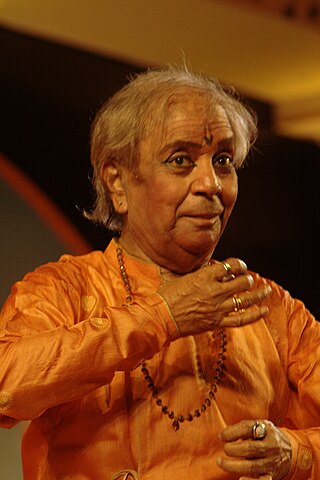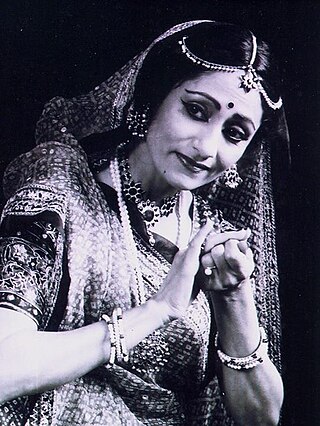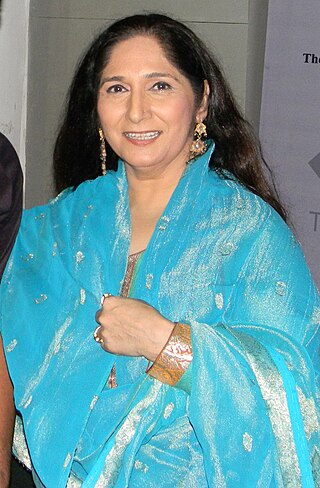
Pandit Birju Maharaj was an Indian dancer, composer, singer, and exponent of the Lucknow "Kalka-Bindadin" Gharana of Kathak dance in India. He was a descendant of the Maharaj family of Kathak dancers, which includes his two uncles, Shambhu Maharaj and Lachhu Maharaj, and his father and guru, Acchan Maharaj. He also practised Hindustani classical music and was a vocalist. After working along with his uncle, Shambhu Maharaj at Bhartiya Kala Kendra, later the Kathak Kendra, New Delhi, he remained head of the latter, for several years, until his retirement in 1998 when he opened his own dance school, Kalashram, also in Delhi.
Pandit Shambhu Maharaj was a Guru of the Lucknow Gharana (school) of the Indian classical dance form, Kathak..Padma Shree Award -1958 Sangeet Natak Academic Award -1967

Uma Sharma is a kathak dancer, choreographer and teacher. She is also runs the Bharatiya Sangeet Sadan, Delhi, a classical dance and music academy, situated in New Delhi, founded by her father in 1946. She is most known for reviving the old classical dance form of Natwari Nritya or the Raslila of Brindavan, which later evolved into the Kathak.
Maharaj Ghulam Hussain Kathak was a classical dancer and teacher.

Aditi Mangaldas is a Kathak dancer and choreographer, who is known for her classical Kathak as well as 'contemporary dance based on kathak" repertoire. Mangaldas is hailed as one of the leading dancers in the field of Kathak in India as well as across the world.
National Institute of Kathak Dance, also known as Kathak Kendra, is the premier dance institution for the Indian classical dance form of Kathak, and a unit of the Sangeet Natak Akademi, India's National Academy of Music, Dance and Drama, situated in New Delhi. Established in 1964, the institution is primarily dedicated to Kathak, though it also offers courses in Hindustani classical music (Vocal) and Pakhawaj and Tabla.

Shriram Bharatiya Kala Kendra (SBKK) is an Indian cultural institution which runs a school for music, dance and performing arts in New Delhi. It was founded by Sumitra Charat Ram in 1952, and imparts training in Indian classical dance styles and music, including Kathak, Bharatanatyam, Odissi, Chhau, Hindustani Classical music, both Vocal and Instrumental. Its associated organisation is the Shri Ram Centre for Performing Arts at Safdar Hasmi Marg, in the Mandi House area, the cultural hub of Delhi, the centre includes a theater for the performing arts, a theatre repertory company and an acting school.
Zaheen Tahira was a Pakistani film and television actress, producer and director. She also worked for Radio Pakistan and on stage.
Sumitra Charat Ram was a noted Indian arts patron, impresario and the founder of Shriram Bharatiya Kala Kendra (SBKK) established in 1952. She played a key role in the revival of performing arts, especially Kathak, in the post-independence era, for which she received a Padma Shri Award.

Rani Karnaa was an Indian classical dancer, known for her proficiency in the Indian dance form of Kathak, and regarded by many as one of the greatest exponents of the art form. She was honoured by the Government of India, in 2014, by bestowing on her the Padma Shri, the fourth highest civilian award, for her services to the field of dance.

Alka Nupur is a former Indian actress who was best known for her contributions to Hindi cinema throughout the 1980s. She appeared in many films throughout her career, including Laawaris (1981), Brij Bhoomi (1982), John Jani Janardhan (1984), and Mohabbat Ke Dushman (1988).
Shobha Deepak Singh is an Indian cultural impresario, photographer, writer, classical dancer and the director of Shriram Bharatiya Kala Kendra, a Delhi-based cultural organization which promotes music and performing arts, through its schools and stage shows. She is known for her contributions for the revival of Mayurbhanj Chhau, a tribal martial dance form from Odisha. The Government of India awarded her the fourth highest civilian award of the Padma Shri in 1999, for her contributions to Arts and culture.

Qasim Riza Shaheen is a British artist and writer based in Manchester. Working across participatory performance, installation, film and photography, Shaheen's practice explores memory, notions of beauty, sexuality, love and, more broadly, fundamental concerns about human nature.

Sushmita Banerjee is a Kathak exponent, choreographer and dance researcher from India. Sushmita has been under the guidance of Pandit Vijay Shankar and Smt. Maya Chatterjee briefly learned from Pandit Birju Maharaj.

Uma Dogra is an Indian exponent of Kathak, an Indian Classical Dance form. She is the senior most disciple of Pt. Durga Lal, the Kathak Maestro from Jaipur Gharana. She is a Kathak soloist, a choreographer and a teacher. She has been performing in India and abroad for more than 40 years.

Nighat Chaudhry was born on 24 February, in Lahore, Pakistan. She moved to London with her parents when she was one year old. She is a trained Sufi & Mystique Kathak classical dancer. She started her journey from London and has been active as a professional Kathak dancer for over three decades. She studied ballet and contemporary dance. She met Nahid Siddiqui aged 14, regarded as one of the greatest Kathak dancers, and trained under her guidance. Inspired to learn the classical forms of her own culture, she abandoned ballet to understand and absorb the nuances of the style. This required her to be closer to its origins and she moved back to Pakistan.
Zareen Panna, also known as Panna or Zarrin is a Pakistani actress and former classical dancer. She acted in both Urdu and Punjabi films.
Rehana Siddiqui was a Pakistani actress. She was known for her roles in dramas Zameen, Fasad Ki Jar, Takmeel, Machalay Ka Sauda, Saat Bhiraie and Barson Baad.
Adeeba Nazeer, also known as Talat Siddiqui was a Pakistani actress and singer. She acted in both Urdu and Punjabi films and is known for her roles in films Ishq-e-Habib (1965), Kon Kisi Ka (1966), Lori (1966), Yaar Maar (1967), Chacha Ji (1967), Behan Bhai (1968), Ladla (1969), Andaleeb (1969), Umrao Jan Ada (1972), Baghi Tay Farangi (1976).










